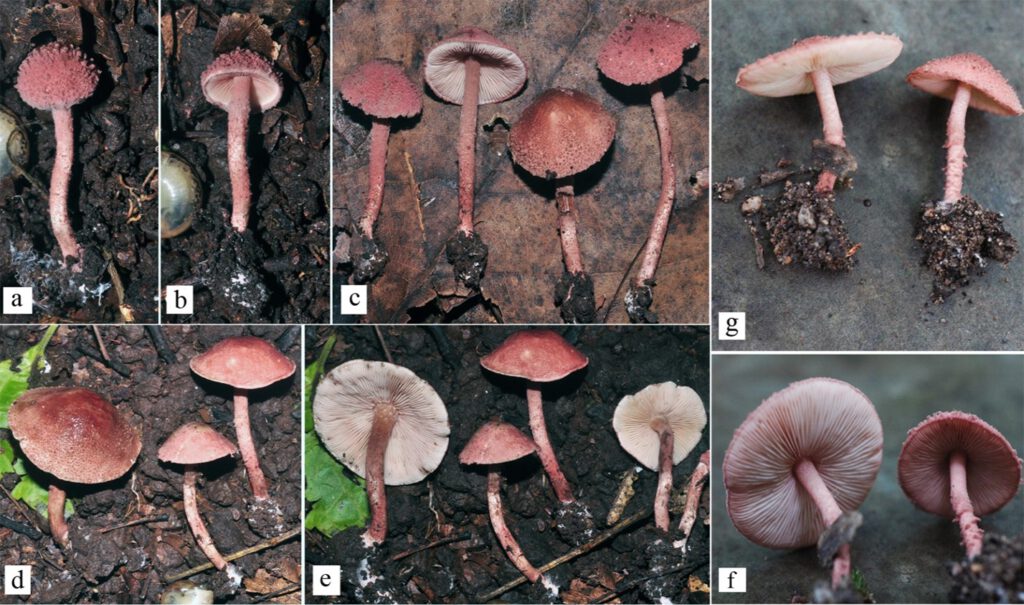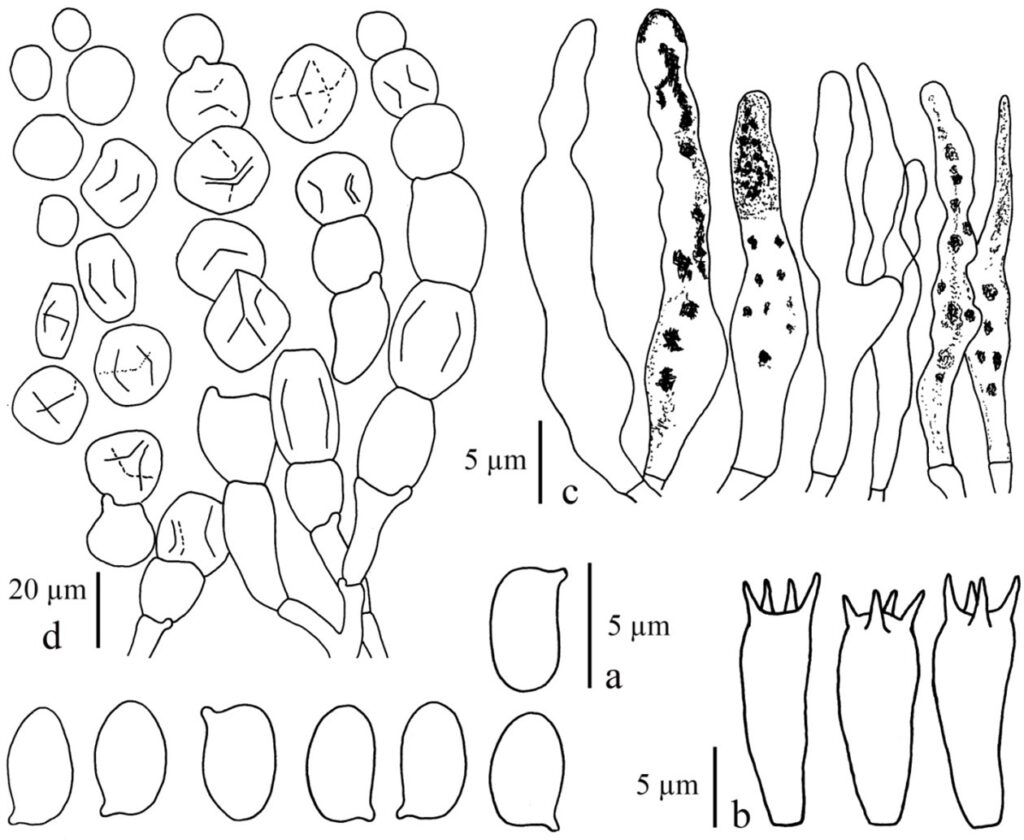Cystolepiota rhodella
MycoBank number: MB ; Index Fungorum number: IF ; Facesoffungi number: FoF 10599;
Description
Pileus 10–32 mm diam., first conical to paraboloid, expanding to campanulate or convex, often umbonate with broad umbo, with straight to incurved margin, completely covered by flocculose squamules when young, violet-brown (10E4–8, 11E6–8) to greyish ruby or ruby (12C5–8, 12D5–8, 12E5–8), darker at center, on drying becoming darker, greyish brown to dark brown (8F3-4), on white to pinkish white or pale red (8A2–3) background; margin with flocculose squamules, concolorous with those on surface, often with white to orange grey (5B2) cortina connecting with stipe when young. Lamellae free, white to whitish, 2–4 mm wide, broadly ventricose, with wavy eroded edge and concolorous with squamules on pileus and stipe. Stipe 25–40 × 2–5 mm, cylindrical, covered with crowded flocculose squamules, concolorous with those on pileus, on white to pinkish white or pale red (8A2–3) background, with white rhizomorphs at base zone; hollow. Annulus an annular zone with concolorous flocculose squamules at upper part of stipe, with concolorous cortina as on pileus margin. Context white in pileus and up to 2 mm thick at umbo, white in stipe. Odor and smell not observed. Spore print white to whitish.
Basidiospores [50,2,2] 3.8–4.2 × 2–3 µm, avl × avw = 4 × 2.4 µm, Q = 1.4–1.9, avQ= 1.7, oblong-ovoid in side view with some straight base and rounded or slightly acute apex, elliposid to oblong in frontal view, hyaline, thick-walled, dextrinoid, non-amyloid. Basida 13–15 × 4.5–6 µm, clavate, hyaline, slightly thick-walled, 4-spored. Lamella edge sterile, with abundant cheilocystidia. Cheilocystidia 35–40 × 4–7 µm, moniliform to flexuous with long appandiculate apex, some narrowly lageniform, with pale yellow mucilaginous contents, hyaline and slightly thick-walled. Pleurocystidia absent. Pileus covering an irregular epithelium composed of globose (12–65 µm diam.) to subglobose (17–23 × 12–18 µm) elements in upper layers, with oblong (25–38 × 15–20 µm) elements in lower layers, thin-walled, with pale brown parietal and intracellular pigments. Stipe covering in the squamules an irregular epithelium same as in pileus covering. Clamp-connections present.
Habitat and distribution – growing solitary or in a small group, saprotrophic on humus-rich soil with dead leaves. There are various habitats e.g. found in mixed deciduous forest with Castanopsis spp. and Lithocarpus spp. dominant in northern Laos, and found in dipterocarp forest with Shorea obtusa Wall. ex Blume dominant and deciduous forest of Ficus annulata Blume. dominant in northern Thailand.
Materials examined – Lao PDR, Oudomxay Province, Xay District, Houay Houm Village, N 20° 31’ 11”, E 101° 53’ 27”, alt. 985-940 m, 12 September 2014, P. Sysouphanthong, P1484 (HNL501799); Thailand, Chiang Rai Province, Pa Daed District, Pha Ngae Village, N 19° 34’ 57”, E 100° 00’ 51”, alt. 510-540 m, 28 August 2018, P. Sysouphanthong, PS2018-138; Chiang Mai, Mae Taeng District, Pong Duad Village, N 16° 06’ 16.1”, E 99° 43’ 07,9”, alt. 780-805 m, 09 August 2007, P. Sysouphanthong, PNG31 (MFLU090050).
GenBank numbers: ITS: MZ574551, MZ574552, MZ574553 (ITS1-F/ITS4).
Note – Cystolepiota rhodella was found in dipterocarp forests in North Laos and North Thailand. It is easily recognized by violet brown or greyish-ruby to ruby squamules on basidiomata, white lamellae with violet brown edge. Because of its unique colour and the coloured lamella edge, the species stands out, and there are few similar species. Melanophyllum haematospermum (Bull.) Kreisel differs from C. rhodella by having cinnamon or pale brownish gray to light grayish brown basidiomata and cinnamon-red to dark brown lamellae (Seok et al. 2013); microscopically it differs in the subtly ornamented, coloured spores, and cystidia that are in general absent or, if present, inconspicuous; the exsiccata turn black (Vellinga 2001). The phylogenetic tree (Fig. 1) showed that C. rhodella is separated from other species; it is basal to the clade made up of specimens of C. hetieri (Boud.) Singer.

Fig. 1 – Cystolepiota rhodella. a-b= PS2018-138, c= HNL501799 (holotype), d-e= PS1484, f-g= PNG31 (MFLU 09-0050).

Fig. 2 – Cystolepiota rhodella (HNL503227, holotype) a= basidiospores, b= basidia, c= cheilocystidia, d= pileus covering elements.
